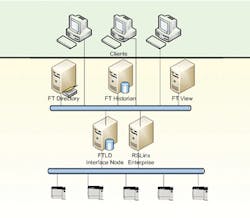Manufacturing Intelligence Relies on Historians for Insight
When production management software first began appearing in plants, plant operators sought answers to such questions as: why is this process, or that, failing? How can I get the most benefit out of fixing it? Since then, production management has undergone a subtle but important cultural shift toward operations management buoyed by the broader concept of Manufacturing Intelligence (MI) and its enabling technologies. MI doesn’t just identify a process bottleneck or an out-of-spec temperature reading; instead, it empowers individuals at all levels of an enterprise to make continuous improvements in their jobs.
While the issues that manufacturers try to address using an MI solution vary—to better manage energy or complex supply chains, for example—the result is the same. MI provides operations with agility to respond to, and succeed in, an ever-changing marketplace.
Making the connection between the plant floor and the front office has not always been easy. As little as two or three years ago, MI was primarily in the evangelizing stage, grappling with challenges surrounding metrics, integration and the cultural divide between controls and Information Technology (IT). But as those challenges have been addressed by open-source solutions, the concept has moved into the mainstream where more and more businesses are using the analytical insights of MI to solve tough business problems. Of course, that insight requires a keen mastery of manufacturing process data and the metrics that make a real difference to the bottom line. For that reason, a reliable historian strategy will always be critical to a successful MI program.
Historians capture time-stamped information on a range manufacturing variables and store that information as a ‘tag’ that can be accessed and used for comparison to other runs of the same product. Of course, processes among manufacturers and industries are wide-ranging. Determining which variables should be captured is no simple task, nor is determining the appropriate level of speed and granularity of data capture. Add to that the external forces that complicate data capture: network speed and bandwidth, a remote location or a difficult plant-floor environment (extreme temperature or vibration, e.g.) and it’s clear that implementing a historian strategy is not a one-size-fits-all proposition.
Data capture in a food processing plant, for example, can range from a single variable (temperature) at one-second intervals; to a single variable at scan rates ten-times that speed on a high-speed line; to a packaging segment that requires data on paper thickness and tautness from 100 points along a six-foot roll that is constantly in motion at a half-second scan rate. The results of a failure almost always include costly downtime and reduced throughput, but there are other impacts, as well. In sugar processing, wandering outside temperature and humidity parameters can result in an explosion. Regulatory standards require painstaking reliability for data capture for pharmaceutical manufacture and wastewater treatment facilities to avoid costly fines. An OEM might embed a historian in a machine to track maintenance data in its customer’s plant to support (or deny) warranty claims.
Three-tiered historian strategy
That complexity is the impetus for the development of the Rockwell Automation distributed Historian strategy. The three-tiered strategy provides a nexus of speed, reliability, and scalability. The series supplies visibility into performance parameters from a single subassembly (FactoryTalk® Historian Machine Edition), to a production line and across the plant (FactoryTalk Historian Site Edition), and with the upcoming release of FactoryTalk Historian Enterprise Edition, across a global enterprise. Either individually or working in concert, the series provides manufacturers with the visibility they need to meet and exceed their competitive performance goals.
So, whether a user needs information on an individual process variable, or needs to compare current production variables with the parameters of a “sweet-spot” in a product’s production history, the Rockwell historian strategy provides critical insight into improving product quality, speeding time-to-market, and supporting regulatory compliance.
Once it’s understand what’s really going on, an analyst might consult any number of production systems to understand how to solve the problem. Take the simple example of a painting operation in an automobile plant. Painting is just one of the thousands of processes on an automotive line. Automobile paint is very expensive…but is also part of the process that is highly visible to the end customer. Too much paint is costly; too little paint, you risk break-through rust spots, color variations, etc. A historian monitors the amount and thickness of the paint used on a vehicle. That information, combined with data about the ambient temperature and humidity inside and outside the paint room, how many cars went through the line that day, provides a baseline for analytics that can be funneled up to an MI system to achieve the desired result: using as little paint as possible (to reduce raw material costs) but just enough to protect the quality and impress the customer.
Still, even with a rational and reliable historian strategy, the key issue is still what an operation does with its visibility. MI shines a light into operations; choosing to fix what may be wrong is still an organizational decision. For most organizations, a vibrant MI program used to be a nice-to-have. Now, it is arguably a must--a question of survival for companies that must drive down their manufacturing costs and improve their performance.
For more information on Manufacturing Intelligence, click here.

